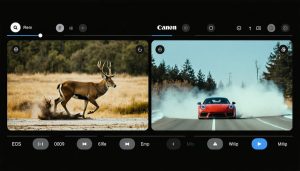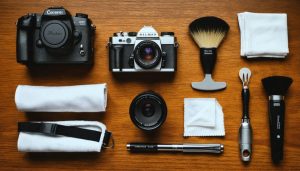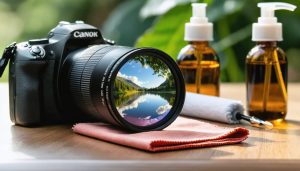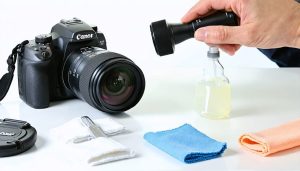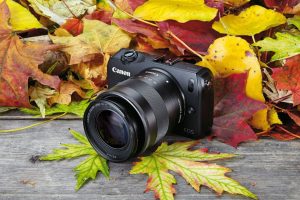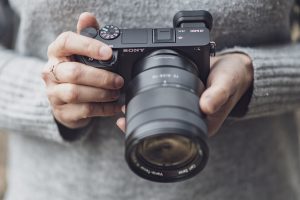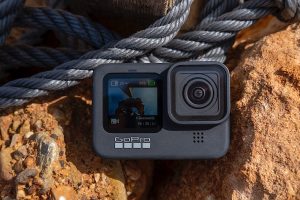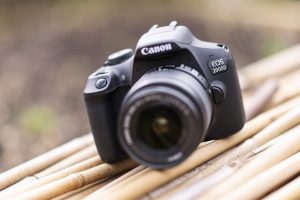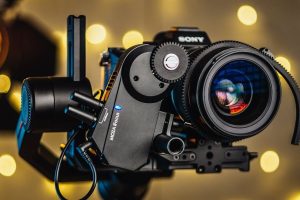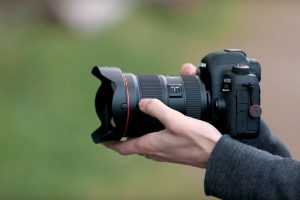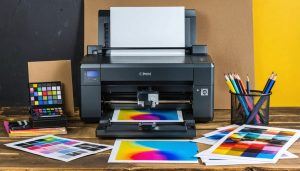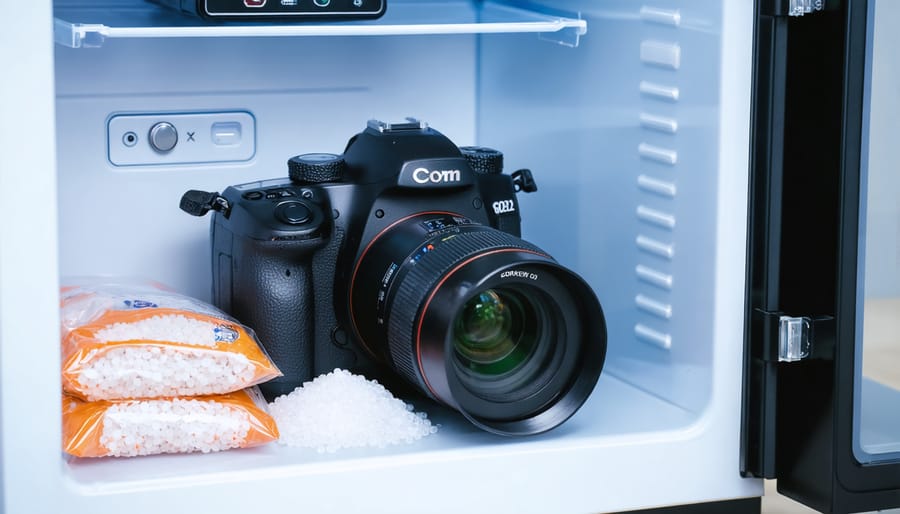
Store your camera with silica gel packets in a sealed, waterproof case to prevent devastating moisture damage that can corrode delicate electronics and foster lens-destroying fungal growth. Understanding humidity control is a critical part of essential camera maintenance, especially when shooting in tropical climates or storing equipment long-term. Professional photographers know that maintaining optimal humidity levels between 35-45% protects thousands of dollars worth of gear from irreversible damage. Humidity-related issues account for nearly 30% of all camera repairs, but implementing proper storage and handling techniques can prevent most moisture-related problems before they start. This comprehensive guide will show you exactly how to shield your valuable photography equipment from humidity’s destructive effects, whether you’re shooting in challenging conditions or storing gear between sessions.
Why Humidity is Your Camera’s Silent Enemy
Signs of Humidity Damage
Recognizing humidity damage early can save your precious camera equipment from severe issues. The most common sign is the appearance of fog or condensation inside your lens or viewfinder, which often occurs when moving between environments with significant temperature differences. If you notice this, it’s crucial to address it through proper professional lens care before it leads to more serious problems.
Other telltale signs include sticky camera controls, unusual resistance when zooming or focusing, and a musty odor emanating from your gear. In more severe cases, you might spot fungal growth appearing as web-like patterns or small spots on lens elements. These typically start at the edges and gradually spread inward. Digital cameras may display erratic behavior, such as malfunctioning buttons or unreliable electronic displays.
The camera’s sensor can also fall victim to humidity, showing mysterious spots in your images that don’t disappear with cleaning. If your memory card slot feels damp or shows signs of corrosion, this is another clear indicator of humidity damage that requires immediate attention.
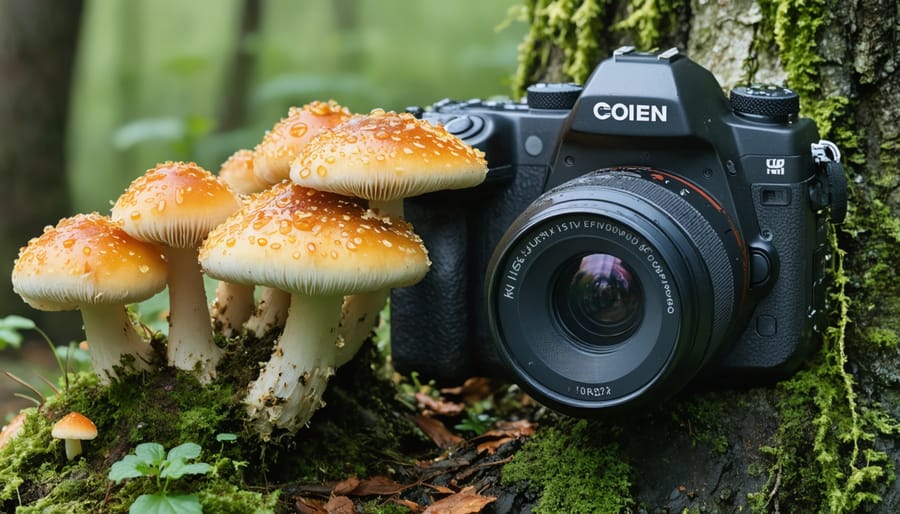
High-Risk Situations
Photographers frequently encounter several situations where humidity poses a significant threat to their equipment. Beach photography sessions, where salt-laden air combines with high moisture levels, create a particularly challenging environment. Similarly, tropical destinations present a double threat with both high temperatures and humidity levels that can quickly overwhelm your camera’s seals.
Indoor-to-outdoor transitions during winter months are especially risky, as rapid temperature changes can cause condensation to form inside your camera body and lens. Wedding photographers often face this challenge when moving between air-conditioned venues and warm outdoor settings.
Rainforest and waterfall shoots present constant humidity challenges, with moisture levels frequently approaching 100%. Even seemingly safe environments like indoor pools and greenhouses can create dangerous conditions for your gear due to their consistently high humidity levels.
Basement studios and storage areas are often overlooked danger zones, where poor ventilation and underground moisture can create ideal conditions for fungal growth on lenses and sensor surfaces. Early morning landscape photography sessions, while beautiful, also expose equipment to heavy dew and fog that can seep into camera bodies.
Practical Solutions for Moisture Control
Storage Solutions
When it comes to protecting your gear from humidity, effective camera storage solutions can make all the difference. The most basic option is a dry cabinet, which uses electronic humidity control to maintain optimal conditions. These cabinets typically keep humidity between 35-45%, perfect for preventing fungal growth and protecting your equipment’s delicate electronics.
For photographers on a budget, desiccant-based storage boxes offer a reliable alternative. These containers use silica gel packets or other moisture-absorbing materials to create a controlled environment. Just remember to regularly check and replace the desiccants every few months to maintain their effectiveness.
Pelican cases with built-in humidity indicators have become increasingly popular among professionals. These rugged containers not only protect against physical damage but also create an airtight seal that prevents moisture infiltration. For added protection, consider adding a layer of moisture-absorbing foam.
DIY solutions can also be effective when properly implemented. A well-sealed plastic container with multiple silica gel packets can work well for short-term storage. Some photographers even use vacuum-sealed bags with desiccants for long-term storage of rarely used equipment.
Remember that whatever storage solution you choose, regular maintenance and monitoring are crucial. Invest in a small hygrometer to keep track of humidity levels, and always ensure your gear is completely dry before storing it.
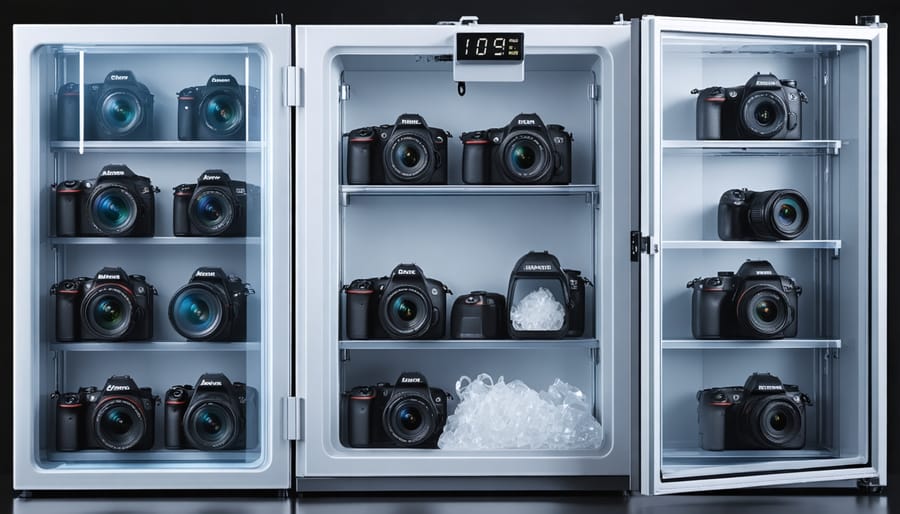
Desiccants and Dehumidifiers
Desiccants and dehumidifiers are your first line of defense against moisture damage in camera equipment. Silica gel packets, the most common type of desiccant, work by absorbing excess moisture from the air. While those tiny packets that come with new electronics are useful, investing in larger, reusable silica gel containers specifically designed for camera gear offers better protection.
For your camera bag, consider using color-indicating silica gel packets that change from blue to pink when they’ve absorbed their maximum moisture capacity. This visual indicator helps you know exactly when to replace or recharge them. To reactivate saturated silica gel, simply heat it in an oven at a low temperature (around 250°F/120°C) for about 2-3 hours.
Electronic dehumidifiers, particularly those designed for camera storage cabinets, provide active moisture control. These devices maintain a constant relative humidity level, typically between 35-45%, which is ideal for camera equipment. Some advanced models even feature digital displays and automatic humidity control.
Moisture-absorbing crystals and dehumidifying strips are alternative options that work well in smaller storage spaces. These products are particularly useful for photographers who store their gear in tight spaces or travel frequently. Remember to check and replace these moisture-absorbing products regularly, especially in humid climates or during rainy seasons.
Smart Monitoring Systems
Modern technology has revolutionized how we protect our camera equipment from humidity damage. Smart monitoring systems now offer photographers peace of mind through real-time tracking and automated alerts, making it easier than ever to maintain optimal storage conditions.
Digital hygrometers with wireless connectivity are leading this revolution. These devices connect to your smartphone, allowing you to check humidity levels remotely and receive instant notifications when conditions become unfavorable. Many models can track historical data, helping you identify patterns and potential risk periods throughout the year.
Some advanced storage solutions come with built-in monitoring systems that automatically activate dehumidifiers or ventilation when needed. These smart cabinets maintain preset humidity levels, typically between 35-45%, ensuring your equipment stays in perfect condition without constant manual intervention.
Environmental monitoring platforms like Bluetooth-enabled sensors can be positioned throughout your storage area, creating a comprehensive humidity mapping system. This is particularly valuable for photographers with extensive collections or those managing multiple storage locations.
For those seeking additional protection, there are smart cases and bags equipped with humidity sensors and moisture-wicking materials. These portable solutions are ideal for photographers who frequently travel to humid locations or work in challenging weather conditions.
When choosing a monitoring system, consider factors like connectivity options, battery life, accuracy ratings, and whether you need remote access capabilities. The investment in smart monitoring technology often pays for itself by preventing costly equipment damage.
Field Protection Strategies
Shooting in Tropical Climates
Shooting in tropical climates presents unique challenges that require specific strategies to protect your gear while capturing those stunning exotic shots. The combination of high humidity and heat can quickly turn a dream shoot into a nightmare if you’re not prepared.
Start your day early when humidity levels are typically lower, and plan indoor breaks during the peak heat hours. Always carry your camera in a waterproof bag with silica gel packets until you’re ready to shoot. When transitioning between air-conditioned spaces and the outdoors, let your equipment gradually adjust to the temperature change to prevent condensation – a good rule of thumb is to wait 15-20 minutes before removing gear from your bag.
Consider using a UV filter to protect your lens from moisture and keep a microfiber cloth handy for quick wipes. Rain covers aren’t just for rain; they can provide excellent protection against humid air while shooting. If you’re planning extended shoots, take advantage of natural ventilation and avoid leaving your camera in direct sunlight.
One often-overlooked technique is to pre-warm your equipment slightly before heading out. This can help prevent condensation from forming on your lens and sensor. When you’re done shooting, resist the urge to immediately pack away your gear. Instead, let it breathe in a dry, shaded area before storing it in your camera bag with desiccants.
Remember to clean your equipment thoroughly after each session, paying special attention to weather sealing and mount points where moisture can accumulate.
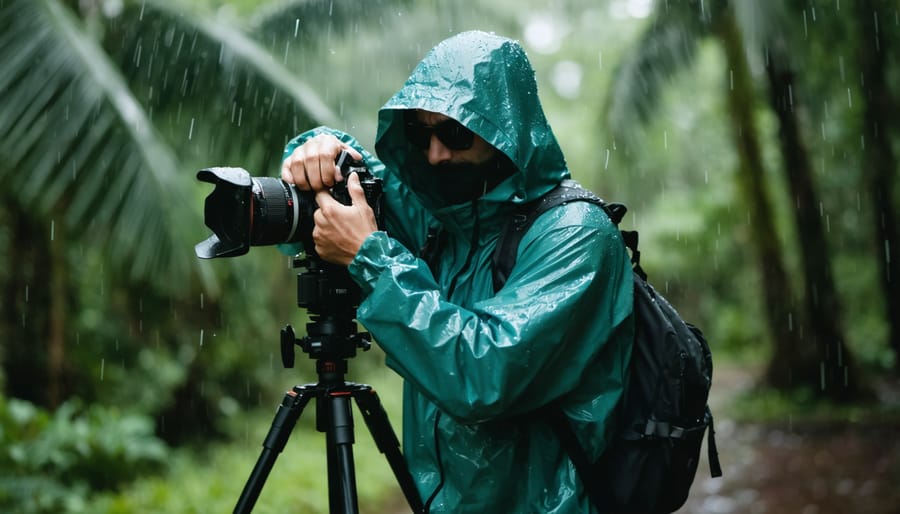
Temperature Transition Management
Moving between different temperature environments can be tricky for your camera gear, especially when transitioning from cold to warm spaces or vice versa. The main concern isn’t just the temperature change itself, but the condensation that forms when warm air meets cold surfaces – much like a cold drink glass on a hot summer day.
To protect your equipment, follow the “gradual transition” rule. When coming in from the cold, place your camera in a sealed plastic bag before entering a warm building. This allows the equipment to warm up slowly while keeping condensation on the outside of the bag rather than on your gear. Give it about 30-45 minutes to acclimate before removing it from the bag.
The same principle applies when moving from air-conditioning to humid outdoor conditions. If you’re heading out for a shoot on a hot day, let your gear adjust in stages. Consider keeping your camera bag closed for the first few minutes after stepping outside, allowing a more gradual temperature transition.
For winter shooting, keep spare batteries close to your body, as cold temperatures can significantly reduce battery life. When storing your gear between shoots, avoid keeping it in places with extreme temperature fluctuations, such as car trunks or uninsulated garages.
Remember to clean your lens thoroughly after these transitions, as any moisture that does form can leave spots or residue that might affect your images.
Emergency Moisture Removal
When your camera has been exposed to high humidity, quick action is essential to prevent potential damage. First, immediately remove the battery and any memory cards, leaving compartments open to promote airflow. Place your equipment in a sealed container with silica gel packets or a professional desiccant – these moisture-absorbing materials are photographers’ best friends in emergencies.
If you don’t have desiccants on hand, uncooked rice can serve as a temporary solution, though it’s less effective than purpose-made products. Place your camera and lens (separated if possible) in an airtight container with the drying agent for at least 24-48 hours. While following these camera maintenance secrets, avoid the temptation to use heat sources like hair dryers, as rapid temperature changes can cause additional problems.
For severe cases, consider using a dedicated dry box or dehumidifying cabinet. If you notice condensation inside the lens or viewfinder, or if your camera shows signs of malfunction after exposure to high humidity, seek professional servicing immediately. Remember that prevention is always better than cure – investing in proper storage solutions and regularly checking your gear can help avoid these emergency situations altogether.
Watch for warning signs like sticky controls, foggy displays, or unusual error messages, as these might indicate moisture-related issues requiring immediate attention. After the drying period, test your equipment thoroughly before any important shoots.
Protecting your camera equipment from humidity is not just about preserving expensive gear – it’s about ensuring your creative tools are always ready when inspiration strikes. Throughout this guide, we’ve explored how excess moisture can threaten your equipment and, more importantly, how to prevent these issues before they arise.
Remember that prevention is always better (and cheaper) than cure. Simple habits like using silica gel packets, storing gear properly, and monitoring humidity levels can save you from costly repairs and equipment failure. Whether you’re shooting in tropical climates or storing equipment during humid summers, maintaining proper humidity control should become as natural as checking your batteries before a shoot.
For professional photographers, your equipment is your livelihood. For enthusiasts, it represents a significant investment in your passion. In either case, implementing the humidity control measures we’ve discussed is essential for protecting your gear and ensuring consistent, high-quality results in your photography.
Don’t wait for fog in your viewfinder or fungus on your lens to take action. Start incorporating these protective measures today, and your camera equipment will thank you with years of reliable service and crystal-clear images.


